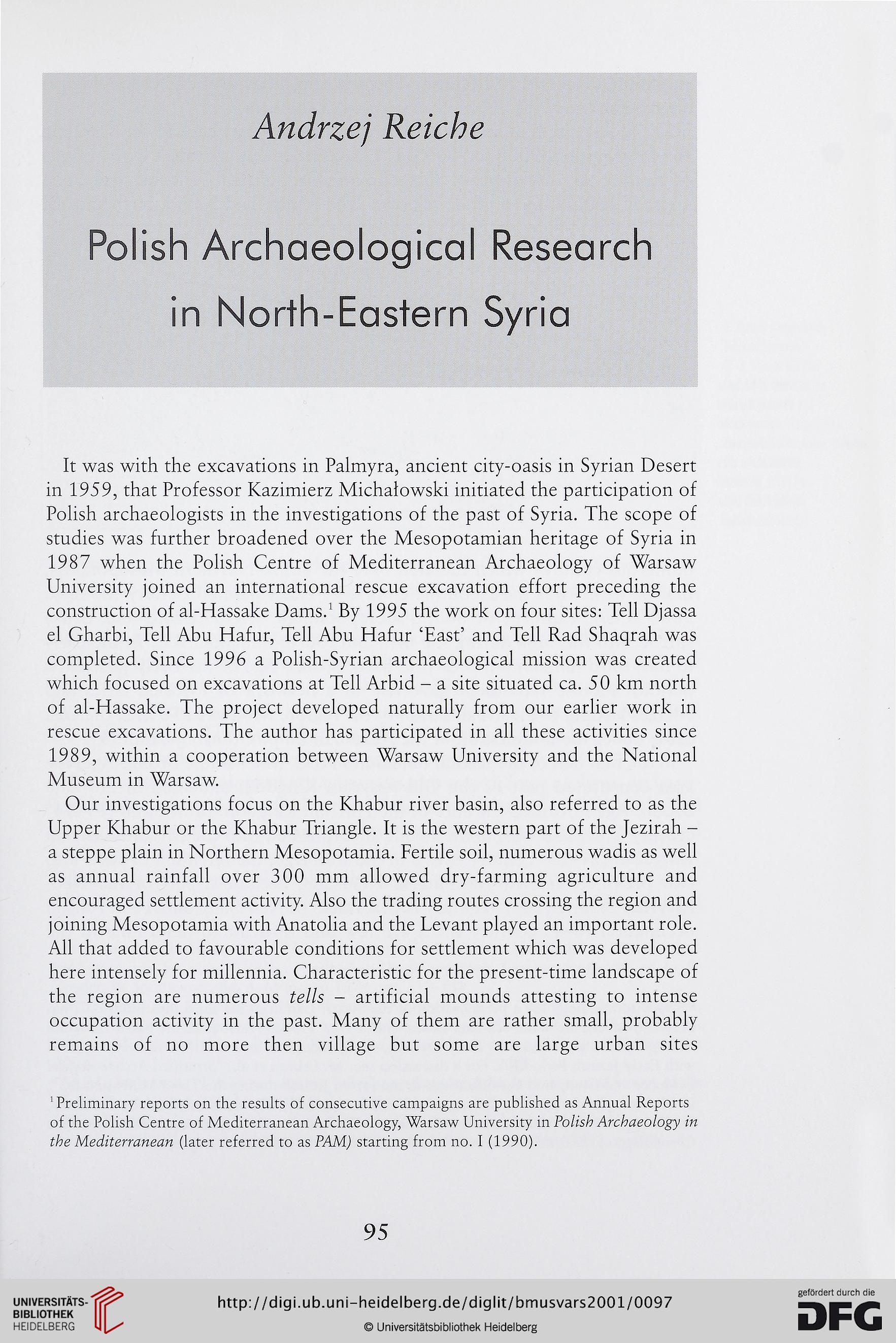Andrzej Reiche
Polish Archaeological Research
in North-Eastern Syria
It was with the excavations in Palmyra, ancient city-oasis in Syrian Desert
in 1959, that Professor Kazimierz Michałowski initiated the participation of
Polish archaeologists in the investigations of the past of Syria. The scope of
studies was further broadened over the Mesopotamian heritage of Syria in
1987 when the Polish Centre of Mediterranean Archaeology of Warsaw
University joined an international rescue excavation effort preceding the
construction of al-Hassake Dams.1 By 1995 the work on four sites: Tell Djassa
el Gharbi, Tell Abu Hafur, Tell Abu Hafur ‘East’ and Tell Rad Shaąrah was
completed. Since 1996 a Polish-Syrian archaeological mission was created
which focused on excavations at Tell Arbid - a site situated ca. 50 km north
of al-Hassake. The project developed naturally from our earlier work in
rescue excavations. The author has participated in all these activities sińce
1989, within a cooperation between Warsaw University and the National
Museum in Warsaw.
Our investigations focus on the Khabur river basin, also referred to as the
Upper Khabur or the Khabur Triangle. It is the western part of the Jezirah -
a steppe plain in Northern Mesopotamia. Fertile soil, numerous wadis as well
as annual rainfall over 300 mm allowed dry-farming agriculture and
encouraged settlement activity. Also the trading routes Crossing the region and
joining Mesopotamia with Anatolia and the Levant played an important role.
All that added to favourable conditions for settlement which was developed
here intensely for millennia. Characteristic for the present-time landscape of
the region are numerous tells - artificial mounds attesting to intense
occupation activity in the past. Many of them are rather smali, probably
remains of no morę then village but some are large urban sites
1 Preliminary reports on the results of consecutive campaigns are published as Annual Reports
of the Polish Centre of Mediterranean Archaeology, Warsaw University in Polish Archaeology in
the Mediterranean (later referred to as PAM) starting from no. I (1990).
95
Polish Archaeological Research
in North-Eastern Syria
It was with the excavations in Palmyra, ancient city-oasis in Syrian Desert
in 1959, that Professor Kazimierz Michałowski initiated the participation of
Polish archaeologists in the investigations of the past of Syria. The scope of
studies was further broadened over the Mesopotamian heritage of Syria in
1987 when the Polish Centre of Mediterranean Archaeology of Warsaw
University joined an international rescue excavation effort preceding the
construction of al-Hassake Dams.1 By 1995 the work on four sites: Tell Djassa
el Gharbi, Tell Abu Hafur, Tell Abu Hafur ‘East’ and Tell Rad Shaąrah was
completed. Since 1996 a Polish-Syrian archaeological mission was created
which focused on excavations at Tell Arbid - a site situated ca. 50 km north
of al-Hassake. The project developed naturally from our earlier work in
rescue excavations. The author has participated in all these activities sińce
1989, within a cooperation between Warsaw University and the National
Museum in Warsaw.
Our investigations focus on the Khabur river basin, also referred to as the
Upper Khabur or the Khabur Triangle. It is the western part of the Jezirah -
a steppe plain in Northern Mesopotamia. Fertile soil, numerous wadis as well
as annual rainfall over 300 mm allowed dry-farming agriculture and
encouraged settlement activity. Also the trading routes Crossing the region and
joining Mesopotamia with Anatolia and the Levant played an important role.
All that added to favourable conditions for settlement which was developed
here intensely for millennia. Characteristic for the present-time landscape of
the region are numerous tells - artificial mounds attesting to intense
occupation activity in the past. Many of them are rather smali, probably
remains of no morę then village but some are large urban sites
1 Preliminary reports on the results of consecutive campaigns are published as Annual Reports
of the Polish Centre of Mediterranean Archaeology, Warsaw University in Polish Archaeology in
the Mediterranean (later referred to as PAM) starting from no. I (1990).
95





